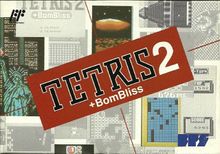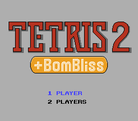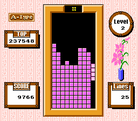Tetris 2 + Bombliss: Difference between revisions
No edit summary |
mNo edit summary |
||
| Line 17: | Line 17: | ||
'''''Tetris 2 + Bombliss'''''{{efn|Known in Japan as: ''Tetorisu 2 + bonburisu'' (テトリス2+ボンブリス)}} is a game for the Famicom developed by Chunsoft and published by [[Bullet-Proof Software]].<ref>http://shmuplations.com/chunsoft30th/</ref><ref>http://web.archive.org/web/20000823075808/http://www.bps.co.jp/04_products/index31.html</ref> | '''''Tetris 2 + Bombliss'''''{{efn|Known in Japan as: ''Tetorisu 2 + bonburisu'' (テトリス2+ボンブリス)}} is a game for the Famicom developed by Chunsoft and published by [[Bullet-Proof Software]].<ref>http://shmuplations.com/chunsoft30th/</ref><ref>http://web.archive.org/web/20000823075808/http://www.bps.co.jp/04_products/index31.html</ref> | ||
''[[Super Tetris 2 + Bombliss]]'' is an updated | ''[[Super Tetris 2 + Bombliss]]'' is an updated version of the same game for the Super Famicom. Both include ''Tetris'' and ''Bombliss'', and both include a battery to save high scores for up to ten players. This game possibly the first to implement four orientations for S, Z, and I tetrominoes. | ||
==Tetris== | ==Tetris== | ||
Revision as of 01:24, 18 October 2020
| Tetris 2 + Bombliss | |
|---|---|
 | |
| Developer(s) | Chunsoft Bullet-Proof Software |
| Publisher(s) | Bullet-Proof Software |
| Platform(s) | Famicom |
| Release |
|
| Gameplay info | |
| Next pieces | 1 |
| Playfield size | 10 × 20 |
| Hold piece | No |
| Hard drop | No |
| Rotation system | BPS rotation (SRS predecessor) |
- Not to be confused with Tetris 2.
Tetris 2 + Bombliss[a] is a game for the Famicom developed by Chunsoft and published by Bullet-Proof Software.[1][2]
Super Tetris 2 + Bombliss is an updated version of the same game for the Super Famicom. Both include Tetris and Bombliss, and both include a battery to save high scores for up to ten players. This game possibly the first to implement four orientations for S, Z, and I tetrominoes.
Tetris
The Tetris modes play similar to other Tetris games, with quick movement and animation.
- A-Type is a standard marathon mode. By default the player can start from levels 0 to 20, with subsequent starting levels available after reaching them in a game. Level increases at 10*(n+1) lines, so that the same number of lines need to be cleared regardless of the starting level.
- B-Type is divided into 30 levels (0-29) and 6 heights (0-5, corresponding to 0, 3, 6, 8, 10, 12 lines of garbage). Clearing 25 lines will pass the stage, causing the player to advance a height. Clearing height 5 will advance the level. An ending occurs on clearing level 29 height 5.
- C-Type is similar to A-Type, but garbage will rise from the bottom at certain intervals. The frequency of garbage depends on the 10-line section:
| Lines | Garbage frequency |
|---|---|
| 0-9 | Every 6 pieces |
| 10-19 | None |
| 20-29 | Every 16 pieces |
| 30-39 | None |
| 40-49 | Every 12 pieces |
| 50-59 | None |
- After 60 lines the table loops.
Bombliss
- For the rules of Bombliss, see Tetris Blast.
This version of Bombliss includes 5-block pentominoes, in addition to the 2-, 3-, and 4-block pieces in other versions of Bombliss. These larger pieces make the game more cumbersome to play than the Game Boy port.
2 Player
2-player is standard versus Tetris, first to 3 wins.
Each player can choose a starting level (0 to 29) and height (0 to 5). Garbage is equal to the number of lines cleared and has a single aligned hole. Both players have the same pieces, matching starting garbage and the same garbage hole.
Notes
- ↑ Known in Japan as: Tetorisu 2 + bonburisu (テトリス2+ボンブリス)
References
External links
| ||||||||

